|
|
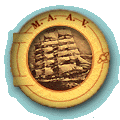
|
|||||||||
|
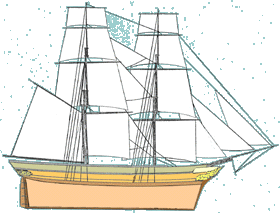
|
| A Snow Brig. The Mountain Maid was a strongly built wooden snow brig. She had two square rigged masts and a smaller sail called a spanker, behind the main mast. (Based on a line drawing from Ships Rigs & Rigging, H. A. Underhill. Nautical Press, Glasgow. Colorised by EFL.) |
![]() n 1984 a site in Port Phillip Bay to the North East of Coles Channel beacon, was identified as the remains of the snow brig Mountain Maid. The Mountain Maid was run down by the steamer Queen on the 24th of September 1856. MAAV members Terry Arnott, Barrie Heard, Bruce Tucker and Jim Anderson rediscovered the Mountain Maid on the 12th of September 1981. The receiver of wrecks was notified and the find was reported in due course to the Victorian Archaeological Survey (VAS) in accordance with the State Historic Shipwrecks Act.
n 1984 a site in Port Phillip Bay to the North East of Coles Channel beacon, was identified as the remains of the snow brig Mountain Maid. The Mountain Maid was run down by the steamer Queen on the 24th of September 1856. MAAV members Terry Arnott, Barrie Heard, Bruce Tucker and Jim Anderson rediscovered the Mountain Maid on the 12th of September 1981. The receiver of wrecks was notified and the find was reported in due course to the Victorian Archaeological Survey (VAS) in accordance with the State Historic Shipwrecks Act.
Following an inspection carried out by a team from VAS headed by Mark Staniforth during October 1983, the MAAV was formally requested, in February 1984, to commence a detailed survey of the site. A team consisting of Barrie Heard, John Marks, Meredith Hewitt and Geoff Hewitt was formed as a consequence and work proceeded on several fronts.
THE SITE
During the 1984 period 34 hours underwater had been logged during 27 dives at the site which is subject to strong tidal current and poor visibility. Following familiarisation and preliminary sketching, the extent of the site to the south of the keelson was determined and major features in this area were located by trilateration using the keelson as baseline.
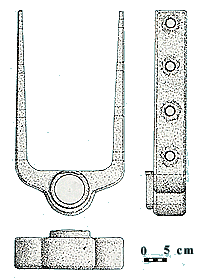
|
| One of the rudder gudgeons raised from the site, MM-3-31-2-1 accords with the dimensions for lower pintle diameter (2 1/2 inch) given in the Lloyd's Survey Report. (Drawn by: Geoff Hewitt) |
The ship evidently came to rest upright on the bottom and appears to have eventually broken up by outward collapse. A major proportion of one side of the vessel, thought to be the port side, lies flat on the bottom to the south of the keelson intact from the wales to the bulwark timbers above the planksheer. Iron deck beam hanging and lodging staple knees, the latter bolted together around no longer existent timber, thus giving a good indication of beam section, lie apparently undisturbed after the deck collapsed downward onto the ceiling.
Despite loss of timbers by erosion and biological activity due to shallow and intermittent burial, a very large and comprehensive amount of intact structure, occupying an area of around 200 square metres is present. This structure promises to yield much information regarding construction method and workmanship.
Airlifting was commenced with the aim of removing sediment from the remains of the port (?) side between planksheer and keelson to permit preparation of a photomosaic. Airlifting operations revealed extensive buried coherent structure beyond the eastern limit (the stern?) of the keelson. Although a working site plan had been commenced using the keelson as datum, it was realized that it would be necessary to extend the baseline to encompass parts of the site previously not apparent.



Photos courtesy Heritage Victoria's, Maritime Heritage Unit. |
SITE IDENTIFICATION
The Mountain Maid, inward from Manila, was carrying a cargo of rice, sugar and rope. Consequently, the presence of bamboo dunnage, appropriate to that source and cargo, is a good pointer to site identity.
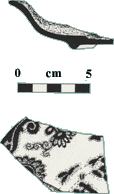 |
| Fragment of blue-patterned white ware, MM-2-29-1-1. (Drawn by: Geoff Hewitt) |
Comparison of scantling dimensions from on-site measurement with Lloyd's rules appropriate to the period show the remains to be not inconsistent with a 194 ton brig sturdily built to those rules. Limited timber speciation has identified red oak and teak in principal structural timbers which, again, is not inconsistent with the seven year Al classification, subsequently continued, of the Mountain Maid. The presence of iron knees and copper fastenings indicates a vessel of European origin. Sheathing metal, apparently copper, has been found on the site in large quantities, in conjunction with a fibrous mat underlay. Lloyd's register records that the Mountain Maid was sheathed with yellow metal over felt. Receipt of a copy of the Lloyd' s Survey Report on the Mountain Maid at building, obtained from the National Maritime Museum, Greenwich has enabled a reasonably conclusive identification to be made. One of the rudder gudgeons raised from the site, MM-3-31-2-1 (illustrated) accords with the dimensions for lower pintle diameter (2 1/2 inch) given in the survey report. This latter document mentions the presence of iron staple knees. Scantling dimensions and extensive use of oak for construction are also in accordance with site observations.

|
| A faceted glass scent (?) bottle MM-4-44-3-1. (Drawn by: Geoff Hewitt) |
RESEARCH
It has been possible to trace the career of the Mountain Maid in some detail since her building at Dundee in 1841. Research of various records at Dundee found details of the vessel, her builders and owner.
We were most fortunate in gaining access to early records of the Port Phillip Sea Pilot Service and located references to the Mountain Maid accident in minute and letter books of that organisation. We also located the original transcripts of evidence taken at an inquiry into the accident and conduct of the pilot held by the Pilot Board. These sources have made available much information in relation to the career of Senior Pilot Francis Paterson and, of course, the circumstances of the collision and sinking.
The information gained will permit useful insights into the workings of the Pilot Service at that time.
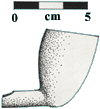
|
| Clay pipe, MM-2-27-1-1. (Drawn by: Geoff Hewitt) |
ARTIFACTS
The Mountain Maid site has shown artifact potential. A number of items were raised and catalogued. Bottles, glass and ceramic fragments underwent conservation. An unusual example of scrimshaw work on a pearly nautilus shell was recovered during the MAU inspection and is presently stored in the care of that Body. Artifact drawings have been prepared for all items to which the MAAV team has had access. Examples of items raised from the site, a faceted glass scent (?) bottle MM-4-44-3-1 a fragment of blue patterned white ware MM-2-29-1-1 and the bowl of a small clay pipe MM-2-27-1-1 are illustrated.
- Do you have any comments or questions regarding the Mountain Maid project report?
- If you have dived on the Mountain Maid have you any comments concerning the site?
- Do you have any information / photographs historical or otherwise which you believe may be useful to the MAAV for inclusion in the project report?
- Full credit will be given to any material if published.